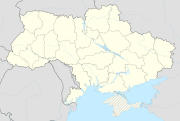Simejis
| Simejis | ||
| Сімеїз | ||

|
|
|
| Basic data | ||
|---|---|---|
| Oblast : | Autonomous Republic of Crimea | |
| Rajon : | Yalta District | |
| Height : | 55 m | |
| Area : | 1.6 km² | |
| Residents : | 3,950 (1/1/2011) | |
| Population density : | 2,469 inhabitants per km² | |
| Postcodes : | 98680 | |
| Area code : | +380 654 | |
| Geographic location : | 44 ° 24 ' N , 34 ° 0' E | |
| KOATUU : | 0111949300 | |
| Administrative structure : | 6 urban-type settlements , 1 selo | |
| Mayor : | Yuri Lomenko | |
| Address: | вул. Зоряна 2 98680 смт. Сімеїз |
|
| Statistical information | ||
|
|
||
Simejis (Ukrainian Сімеїз ; Russian Симеиз / Simeis ) is an urban-type settlement on the Crimean peninsula .

geography
The place is located directly on the Black Sea in the southeast of the Crimea. Together with the five urban-type settlements of Berehove (Берегове), Holuba Zatoka (Голуба Затока), Kaziweli (Кацівелі), Parkowe (Паркове) and Ponysiwka (Понизівелз), as well as the settlement of the same name as Понизівелз, forms the Settlement Settlement.
history
In the vicinity there are dolmens and fortifications that date back to the early Middle Ages. At that time the area was controlled by the Byzantine Empire . A former monastery may have given the city its current name. As the Byzantine Empire gradually shrank, the area fell under the control of Genoa and later became part of the Ottoman Empire. When the Christian population left in 1778, the city was almost depopulated.
In 1828 the entrepreneur Iwan Akimowitsch Malzow took over the town and expanded it into an orchard. His descendants expanded them into a resort with parks and villas. After the October Revolution, everything was nationalized and sanatoriums built for tuberculosis sufferers. In the high season of 1927 around 10,000 people visited the city.
During the Second World War the city was occupied by the Germans and liberated by the Red Army in April 1944 . By 1955 the city experienced a new beginning.

